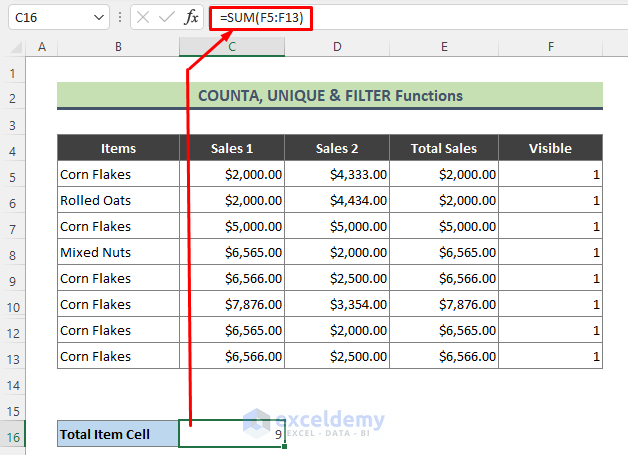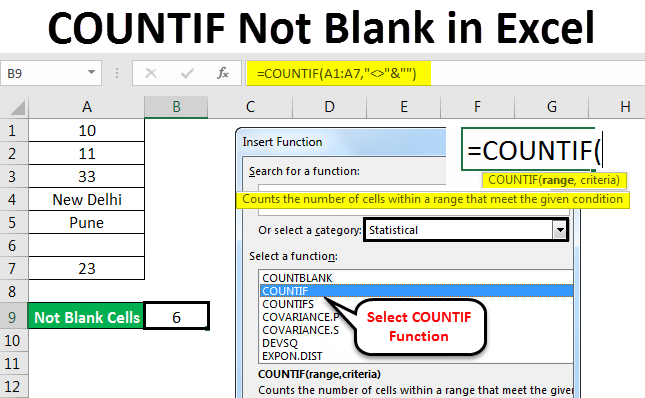Mastering COUNTIF for Visible Cells: 5 Tips

In the world of data analysis and spreadsheet management, the COUNTIF function is a powerful tool that allows users to efficiently count specific values or conditions within a dataset. While this function is versatile and widely used, it can sometimes be challenging to apply it accurately, especially when dealing with visible cells and hidden rows or columns. This article aims to provide a comprehensive guide on mastering the COUNTIF function for visible cells, offering practical tips and insights to enhance your data analysis skills.
Understanding the COUNTIF Function

The COUNTIF function is a built-in feature in spreadsheet applications like Microsoft Excel and Google Sheets. It enables users to count cells that meet a certain criterion or condition. This function is particularly useful when working with large datasets, as it automates the process of counting specific values, saving time and effort. Here’s a simple example to illustrate its functionality:
=COUNTIF(range, criteria)
In this formula, range refers to the cell range you want to evaluate, and criteria defines the condition or value you're looking for. For instance, if you want to count the number of cells containing the value "Apple" in a dataset, your formula would be:
=COUNTIF(A2:A10, "Apple")
This formula counts the number of times the word "Apple" appears in the range A2 to A10.
5 Tips for Mastering COUNTIF for Visible Cells

While the COUNTIF function is straightforward, it becomes more intricate when dealing with visible cells in a dataset that may have hidden rows or columns. Here are five expert tips to help you master this function for visible cells:
1. Define Your Visible Cell Range
Before applying the COUNTIF function, it’s crucial to define the visible cell range accurately. This range should only include the cells you want to analyze and exclude any hidden rows or columns. You can use the Special Cells feature in Excel to identify and select only the visible cells in your dataset. In Google Sheets, you can utilize the Filter feature to achieve the same result.
2. Utilize Absolute References
When dealing with large datasets, it’s common to have dynamic ranges that expand or contract. To ensure the COUNTIF function remains accurate even when the dataset changes, consider using absolute references. By fixing the range reference with the $ symbol, you can prevent the function from adjusting the range when the dataset is modified. For instance, if your visible cell range is fixed, you could use:
=COUNTIF($A$2:$A$10, "Apple")
3. Combine COUNTIF with Other Functions
The COUNTIF function can be combined with other spreadsheet functions to create more complex formulas. For example, you might want to count visible cells that meet multiple conditions. In such cases, you can use the AND function along with COUNTIF to specify multiple criteria. Here’s an example:
=COUNTIF(A2:A10, "Apple") * COUNTIF(B2:B10, "Banana")
This formula counts the number of cells containing "Apple" in column A and "Banana" in column B, providing a more specific analysis.
4. Handle Errors and Blank Cells
When using the COUNTIF function, it’s important to consider errors and blank cells in your dataset. By default, the function counts blank cells as zero. If you want to exclude blank cells from your count, you can use the ISBLANK function along with COUNTIF to ignore them. Here’s an example:
=COUNTIF(A2:A10, "Apple") - COUNTIF(A2:A10, "")
This formula counts the number of cells containing "Apple" and subtracts the number of blank cells, providing an accurate count.
5. Visualize Your Data with Conditional Formatting
Conditional formatting is a powerful tool that allows you to visualize your data based on specific conditions. It can be particularly useful when working with the COUNTIF function. You can apply conditional formatting to highlight cells that meet certain criteria, making it easier to identify patterns and trends in your dataset. For instance, you could format cells to display a specific color if they contain the value “Apple.”
Performance Analysis and Considerations
The performance of the COUNTIF function can vary depending on the size and complexity of your dataset. While it’s generally efficient for small to medium-sized datasets, large datasets with numerous conditions can impact performance. In such cases, consider optimizing your formula by breaking it down into smaller, more manageable chunks. Additionally, ensure that your dataset is properly structured and organized to minimize unnecessary calculations.
Future Implications and Enhancements
As spreadsheet applications continue to evolve, we can expect further enhancements to the COUNTIF function and its related features. Developers are likely to focus on improving performance for large datasets and adding more sophisticated conditional options. Additionally, the integration of machine learning and artificial intelligence could lead to more intuitive and automated data analysis tools, further enhancing the capabilities of functions like COUNTIF.
| Version | Enhancements |
|---|---|
| Excel 2022 | Introduced a new "Smart Filter" feature that automatically suggests relevant conditions based on your data. |
| Google Sheets 2023 | Added support for nested COUNTIF functions, allowing users to apply multiple conditions within a single formula. |

Can I use COUNTIF to count cells based on multiple conditions simultaneously?
+Yes, you can use the AND function along with COUNTIF to specify multiple conditions. This allows you to count cells that meet all the specified criteria.
How can I exclude blank cells from my COUNTIF calculation?
+To exclude blank cells, you can use the ISBLANK function along with COUNTIF to ignore blank cells in your count.
Are there any alternatives to COUNTIF for more advanced counting and filtering tasks?
+Yes, functions like SUMIFS and FILTER (in Google Sheets) offer more advanced filtering and counting capabilities. These functions can handle more complex conditions and provide more flexibility in your data analysis.



